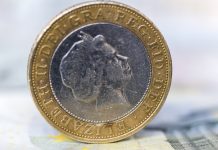Cautious Brexit optimism, US political uncertainty and some concerns from the Federal Reserve, sent the pound US dollar exchange rate to a peak of US$1.2936. This is a fresh two week high for the pound versus the dollar.
| What do these figures mean? |
|---|
|
When measuring the value of a pair of currencies, one set equals 1 unit and the other shows the current equivalent. As the market moves, the amount will vary from minute to minute. For example, it could be written: 1 GBP = 1.28934 USD Here, £1 is equivalent to approximately $1.29. This specifically measures the pound’s worth against the dollar. If the US dollar amount increases in this pairing, it’s positive for the pound. Or, if you were looking at it the other way around: 1 USD = 0.77786 GBP In this example, $1 is equivalent to approximately £0.78. This measures the US dollar’s worth versus the British pound. If the sterling number gets larger, it’s good news for the dollar. |
The pound was in demand on Wednesday as investor optimism towards Brexit crept higher. A quiet UK economic calendar has meant that investors are focused on Brexit developments. Whilst concerns of a no deal Brexit dragged the pound lower over the past few weeks, faint hopes that the the UK and the EU will manage to put a deal together are starting to appear and lift the pound.
UK Brexit Secretary Dominic Raab sounded confident that a Brexit deal will be in place by mid-October. The Brussels have said that they believe a deal will be achieved around November, slightly after the self-imposed deadline but still within an acceptable margin. These comments have given investors a glimmer of hope that the UK might not come crashing out of the EU without an agreement.
| Why is a “soft” Brexit better for sterling than a “hard” Brexit? |
|---|
| A soft Brexit implies anything less than UK’s complete withdrawal from the EU. For example, it could mean the UK retains some form of membership to the European Union single market in exchange for some free movement of people, i.e. immigration. This is considered more positive than a “hard” Brexit, which is a full severance from the EU. The reason “soft” is considered more pound-friendly is because the economic impact would be lower. If there is less negative impact on the economy, foreign investors will continue to invest in the UK. As investment requires local currency, this increased demand for the pound then boosts its value. |
Today investors will continue to watch Brexit development. Sales data from the Confederation of British Industry will always provide a distraction. Analysts are expecting retail sales to have declined in August after July’s impressive figures owing to the hot weather and England’s success in the World Cup. Should the numbers disappoint, the pound could drop lower.
Fed Fret Over Next Recession
The dollar was under pressure in the previous session. Political risk stemming from the conviction of Trump’s campaign chairman and the guilty plea of Trump’s former lawyer in addition to the implication of the President himself, have unnerved investors.
Pressure on the dollar then increased after the release of the Federal Open Monetary Committee (FOMC) minutes from the meeting at the end of July. The minutes showed that Fed policy makers were confident that strong economic growth will continue at least for the months to come. They also said that they believe that another hike could be required soon. However, policymakers at the Fed then turned their attention to an in-depth discussion about how effective their current tools would be should a major recession strike. A number of key risks were flagged in the discussion such as the developing trade war and recession signals from the bond market. This hit sentiment in general and pulled the dollar lower.
Today investors will look towards the start of the Jackson Hole Symposium in Wyoming for further details from Fed policy makers and central bankers. Jerome Powell will speak on Friday.
This publication is provided for general information purposes only and is not intended to cover every aspect of the topics with which it deals. It is not intended to amount to advice on which you should rely. You must obtain professional or specialist advice before taking, or refraining from, any action on the basis of the content in this publication. The information in this publication does not constitute legal, tax or other professional advice from TransferWise Inc., Currency Live or its affiliates. Prior results do not guarantee a similar outcome. We make no representations, warranties or guarantees, whether express or implied, that the content in the publication is accurate, complete or up to date. Consult our risk warning page for more details.
This article was initially published on TransferWise.com from the same author. The content at Currency Live is the sole opinion of the authors and in no way reflects the views of TransferWise Inc.





